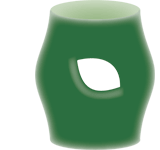Abstracts of Talks
Andrew Dancer, Oxford University
Symplectic Versus Hyperkahler Geometry
We decribe how ideas from symplectic geometry can inspire constructions in other geometries, in particular the hyperkahler setting. We focus particularly on the constructions of cutting and implosion.
Dancer Lecture Notes (PDF)
Hansjörg Geiges, University of Cologne
Contact Dehn Surgery
Contact Dehn surgery was introduced by Fan Ding and the speaker as a means to construct weakly but not strongly symplectically fillable contact 3-manifolds. I shall describe this method, with emphasis on a surgery presentation theorem for contact 3-manifolds (which may be thought of as the contact analogue of the Lickorish-Wallace theorem). In combination with Heegaard Floer theory, this surgery presentation theorem has turned out to be a powerful tool (in the hands of Lisca and Stipsicz, for instance) for the classification of contact 3-manifolds. I also plan to discuss Kirby moves in contact surgery diagrams.
Viktor Ginzburg, University of California at Santa Cruz
Leaf-wise Coisotropic Intersections
One of the fundamental results in symplectic topology is the Lagrangian intersection property: a Lagrangian submanifold necessarily intersects its image under a Hamiltonian diffeomorphism, which is in a certain sense close to the identity.
The Lagrangian intersection property has several different generalizations to coisotropic manifolds. In this talk, we discuss, drawing heavily on a recent work of Gurel, one particularly intriguing aspect of the coisotropic intersection property. This is the existence of the so-called leaf-wise intersections, which is closely connected to some problems in geometric mechanics and string theory.
Ginzburg Lecture Notes (PDF)
Rebecca Goldin, George Mason University
Equivariant Cohomology in Symplectic Geometry
Equivariant cohomology is a powerful, useful, and computable invariant in the context of Hamiltonian geometry. I will illustrate how basic properties of this cohomology theory allow us to gain topological information about symplectic manifolds with Hamiltonian actions, as well as a large class of symplectic orbifolds that arise as symplectic reductions. In particular, techniques in equivariant cohomology have been successfully used in the study of Schubert calculus, GKM spaces, weight varieties (including polygon spaces) and, more recently, in the study of Chen-Ruan (orbifold) cohomology. Many of the themes and theorems have K-theoretic analogues as well.
Goldin Lecture Notes (PDF)
Richard Kenyon, Brown University
The Configuration Space of Branched Polymers
In this talk a “branched polymer” will be a connected collection of unit balls with non-overlapping interiors. Building on and from the work of Brydges and Imbrie, we give an elementary calculation of the volume of the space of branched polymers with n balls in the plane and in 3-space. Our development reveals some more general identities, and allows exact random sampling. In particular we show that a random 3-dimensional branched polymer with n balls has diameter of order √n. (This is joint work with Peter Winkler.)
Ian Leary, Ohio State University
Infinite Smith Groups
A classical result of P. A. Smith implies that whenever a finite group of prime power order acts on a finite-dimensional contractible space, there is a global fixed point for the action. Recently six authors have together constructed an infinite discrete group with this property. I will describe the construction of this group and a (3-author) application of this method to the study of P. H. Kropholler's ‘hierarchy of groups.’
(This is joint work with G. Arzhantseva, M. Bridson, T. Januszkiewicz, P. H. Kropholler, A. Minasyan, J. Swiatkowski.)
Kaoru Ono, Hokkaido University
Floer Theory for Lagrangian Submanifolds
I will speak on the theory of filtered A∞-algebras associated to relatively spin Lagrangian submanifolds and filtered A∞-bimodules associated to relative spin pairs of Lagrangian submanifolds. After introducing the general framework, I would like to explain the case of Lagrangian torus fibers in toric manifolds. All the contents are joint works with K. Fukaya, Y.-G. Oh and H. Ohta.
Ono Lecture Notes and Extras (PDF)
Peter Ozsváth, Columbia University
Heegard Diagrams and Holomorphic Disks
Heegaard Floer homology is an invariant for closed, oriented three-manifolds defined by counting holomorphic disks in an associated symplectic manifold. There is also an closely related knot invariant, knot Floer homology. I will describe recent progress in combinatorial calculations of some of these invariants, with a focus on the case of classical knots, along with some applications. The talk will include joint work with Ciprian Manolescu, Sucharit Sarkar, Andras Stipsicz, Zoltan Szabo, and Dylan Thurston.
Katrin Wehrheim, Massachusetts Institute of Technology
Construction of Topological Invariants Via Decomposition and Representation in a Symplectic Category
A Lagrangian correspondence is a Lagrangian submanifold in the product of two symplectic manifolds. This generalizes the notion of a symplectomorphism and was introduced by Weinstein in an attempt to build a symplectic category that has morphisms between any pair of symplectic manifolds (not just symplectomorphic pairs). In joint work with Chris Woodward we define such a cateory, in which all (generalized) Lagrangian correspondences are composable morphisms. We extend it to a 2-category by extending Floer homology to generalized Lagrangian correspondences. This is based on counts of 'holomorphic quilts' — a collection of holomorphic curves in different manifolds with 'seam values' in the Lagrangian correspondences. A fundamental isomorphism of Floer homologies ensures that our constructions are compatible with the geometric composition of Lagrangian correspondences. This provides a general prescription for constructing topological invariants. We consider e.g. 3-manifolds or links as morphisms (cobordisms or tangles) in a topological category. In order to obtain a topological invariant from our generalized Floer homology, it suffices to
- decompose morphisms into simple morphisms (e.g. by cutting between critical levels of a Morse function)
- associate to the objects and simple morphisms smooth symplectic manifolds and Lagrangian correspondences between them (e.g. using moduli spaces of bundles or representations)
- check that the moves between different decompositions are associated to (good) geometric composition of Lagrangian correspondences
Shmuel Weinberger, University of Chicago
Manifolds Whose Universal Covers Have Finite Type
I will discuss some generalizations of the theorem (in high dimensions due to Browder and Levine) that manifold with infinite cyclic fundamental group is a fiber bundle over the circle iff its universal cover has finitely generated homology.
